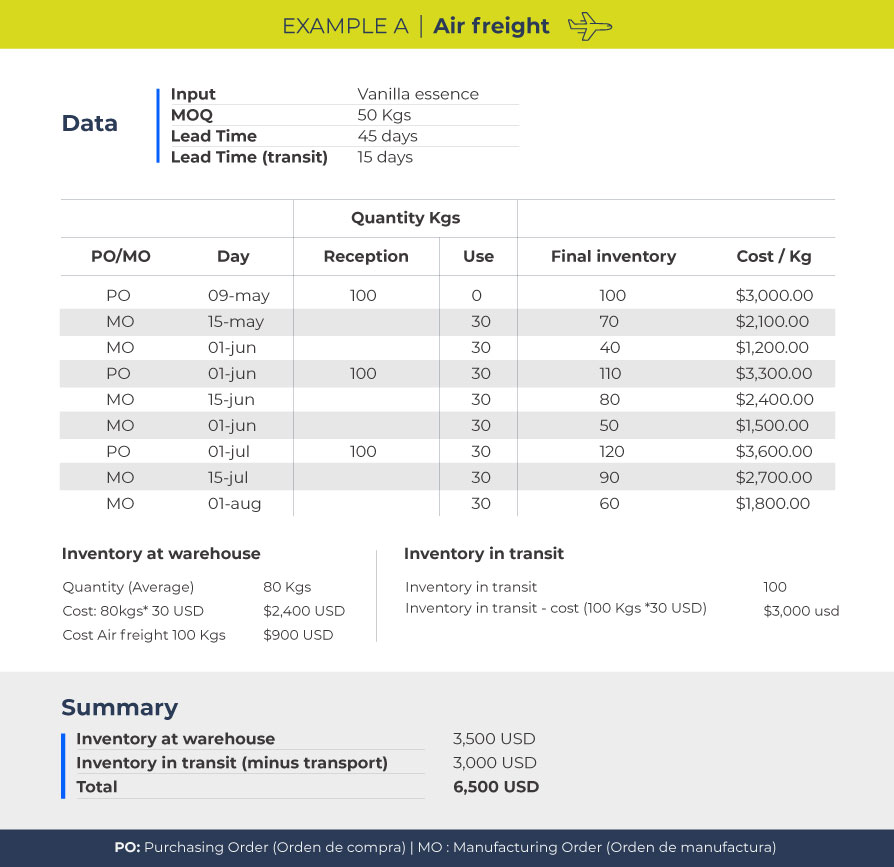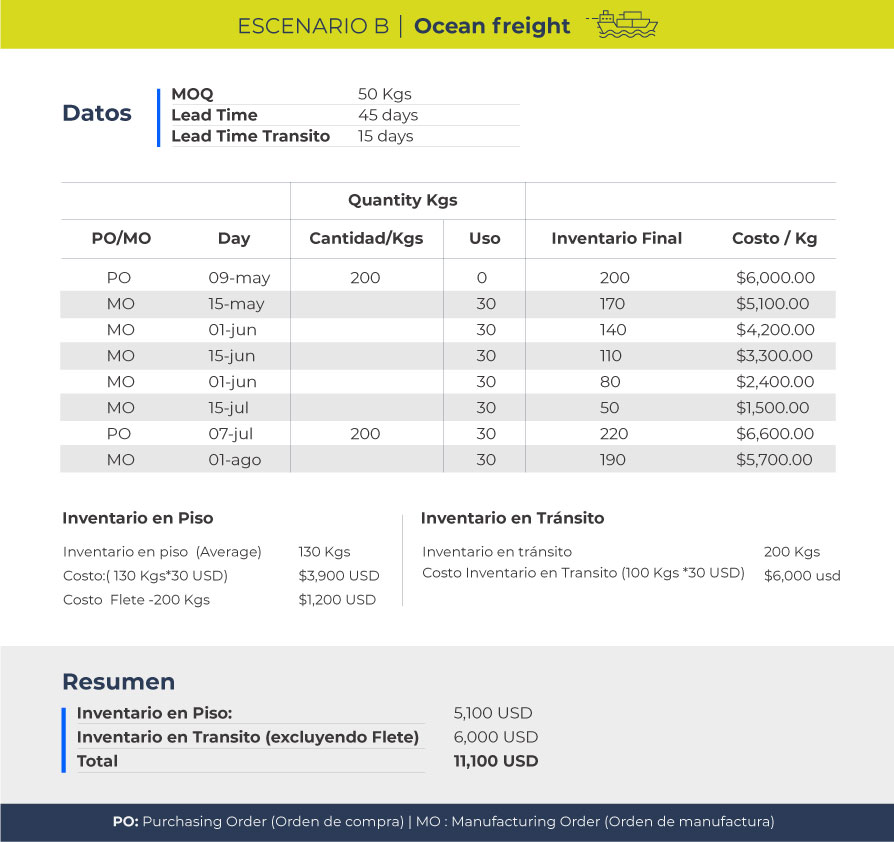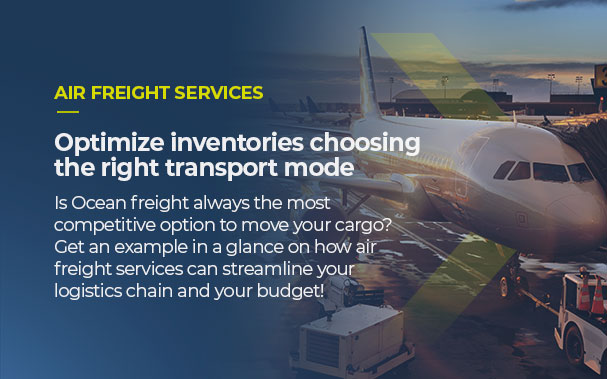Cost, volume, and inventory turnover are some of the items that can be positively impacted by choosing air transport solutions in your logistics plans.
We know that optimizing inventory levels is a very complex and challenging activity for manufacturing professionals. We understand it goes beyond having “less inventory.”
It is really about having the right mix of products that enable you to meet the planned – or unplanned! – demand of your customers and, thus, ensure your company’s financial health, avoiding losses in sales and inputs.
In this sense, it is important to recognize all the materials that are part of this equation:
- Raw materials
- Indirect premium materials (packaging materials)
- Semi-finished products
- Indirect materials, such as spare parts and machinery
Considering that the level of inventories is directly related to the main indicators of the supply chain due to the impact it has on your organization’s cash flow, liquidity, indebtedness, and profitability, it is essential that you can get the support of experts who can design adequate logistics plans to meet these needs.
Choosing air freight solutions enables you
to optimize stock and lower financial risks
There are certain conditions that favor the design of an optimal logistics plan for supply chains using air freight solutions. And it’s not just the specialized industry that has these needs!
We are part of a globalized business environment. That’s why it is so important to analyze and redesign inventory strategies as a consistent practice.
What conditions favor choosing air freight solutions?
- Your stock has a high cost per kilo or per unit: in many cases, maintaining inventories on hold generates a higher cost than a streamlined logistics plan, which works with reduced inventory levels.
- Your stock rotates slowly: This scenario occurs when the use of materials is frequent, but in small quantities. Inventory turnover measures how much you’re turning your inventories around.This becomes an opportunity cost because, the more stock you have at hand but unused, means that you are misallocating your financial resources, since you can use them by financing and selling to customers instead of leaving the money still. Instead, if you move the product with low consumption using air freight solutions instead of maintaining a high level of stock, you improve your profitability.
- Stock with little use, made up of products that are not used very often. In particular, these inventories correspond to new products, to In & Out products (that are for sale for a limited time pnly) or to products sold only on request.
- Purchase minimums: The purchasing minimums established by suppliers will define whether it is possible to design solutions using 100% air freight services or hybrid logistics plans, which consider more than one mode of transport).
- Location of the supplier (how far away/close is the supplier): The farther away the supplier is, the greater the risk of not delivering on time, so it is important to always maintain alternative channels – or have critical cargo services at hand – that allow access to the product in less time.
Let’s go over an example
Let’s think about a company in the beverage sector called “KAAFFEE”.
KAAFFEE is dedicated to selling hot coffee in vending machines spread through sales points – such as convenience stores.
The product that is inserted into these vending machines are sachés with the powdered product prepared and stocked until the moment when the final customers (consumers) place a cup and presses a button.
KAAFFEE’s flagship product is a vanilla-flavored coffee.
Tons of product are sold monthly and its production cycle is biweekly.
The ingredients of this prepared formula are: coffee, milk powder, sugar, stabilizers and vanilla essence – which in turn is prepared with vanilla pods from Madagascar, manufactured to essence in the United States.
Although we wanted to look for a local supplier, we have not been successful in finding the same quality; 12 kilos of essence are used for each ton of coffee and 2.5 tons of coffee are produced fortnightly – this means that 60 kilos of the product are consumed monthly.
The cost per kilogram of vanilla essence is USD 30. The minimum order quantity (MOQ) is 50 kilograms, and the response time is 45 days.
The transit time – considering the point of collection to delivery in the plant – is 35 days by Ocean Freight services.
Data summary:
- Monthly consumption: 60 kilos
- Transit Time: 45 days
- Cost per Kilogram: USD 30
- MOQ: 100 Kilograms
- Cost per MOQ: USD 3,000
- Minimum inventory that must be available: 90 kg (equivalent to 45 days of supplier response time)
Considering the elements above, and doing a practical exercise, we can see in the tables below that if KAAFFEE bets on an air freight solution, it will have a total cost of USD 3,500 stock at the factory + USD 3,000 of stock in transit.
If they opt for an ocean freight solution, the total cost of the stock at the factory would be USD 5,100, plus the cost of their stock in transit – which includes the cost of raw materials already ordered with the supplier which would be USD 6,000.
The more inventory you have, the more financial risk you will generally have. Check in the table below the lines of costs in the factory and in transit, plus the freight costs.
Do you see that using air solutions is a better option?
Additional advantage of air freight services: you can react more quickly to any change.


In our next article in the series on the advantages of air freight solutions, we will discuss how this transport mode can help your supply chain reduce risks due to inventory obsolescence and/or expiration.
Why should you choose Europartners Group’s
air freight solutions?
With 20 years of experience in the global logistics market, we specialize in programmed air freight solutions and time critical cargo solutions, too.
In addition to multimodal alternatives, we offer comprehensive logistics consulting and professional services dedicated to your company, with key account managers and in-house solutions.
We have air consolidation services from different parts of the world to guarantee you spaces and local presence in some of the main airports in the Americas.
Connect with us. We are Europartners Group. Connecting minds to move the world.
 ESPAÑOL
ESPAÑOL





